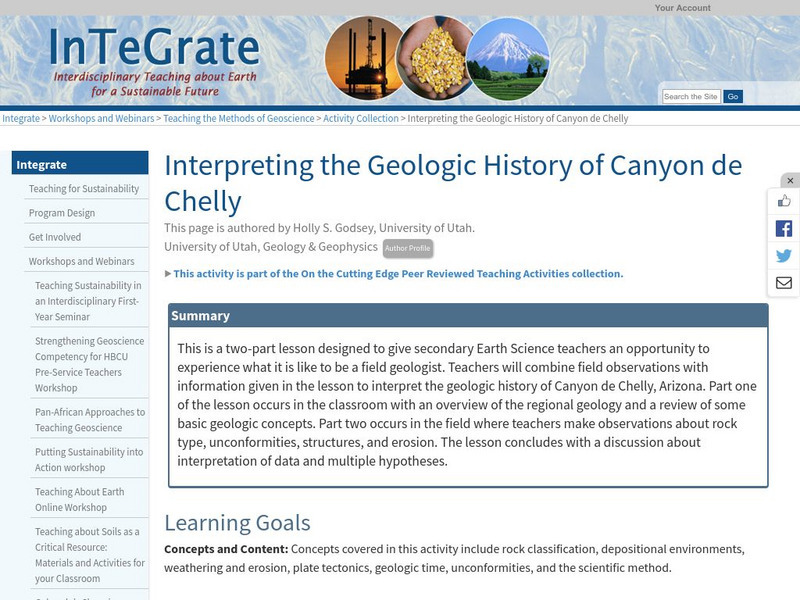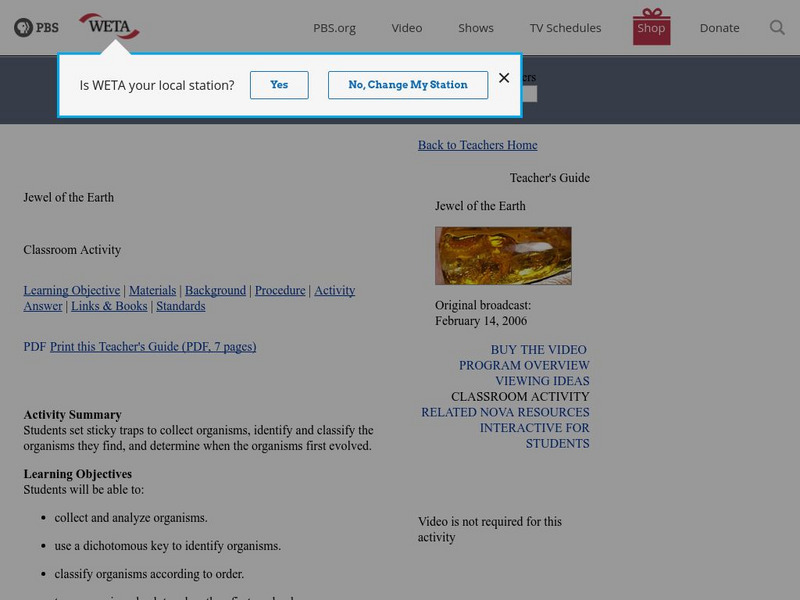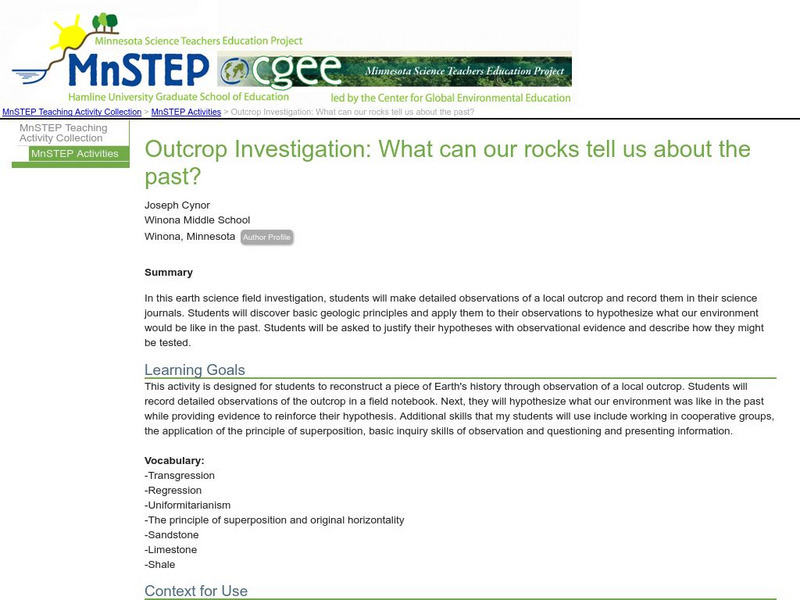Khan Academy
Khan Academy: Activity: Claim Testing: Geology and the Earth's Formation
An activity where students investigate how scientist study plate tectonics.
Khan Academy
Khan Academy: Activity: What Do You Know? What Do You Ask?
Put together your best team of scientist to figure out if would be possible for humans to inhabit Mars with this activity. Students learn about the interdisciplinary approach to solving a problem.
American Geosciences Institute
American Geosciences Institute: Earth Science Week: Third From the Sun
Students learn about the history of Earth imaging, the Landsat satellite program. They develop interpretation skills as they play a game that involves inferring the subjects of various Landsat images.
American Geosciences Institute
American Geosciences Institute: Earth Science Week: Celebrate Wilderness
In this activity, students research a wilderness refuge near them or through online resources. They will investigate the history of a refuge and how indigenous people lived there long ago, as well as the lives of any descendants of these...
Khan Academy
Khan Academy: Activity: Planet Card Sort
An activity that allows students to make inferences and guesses on how planets form.
Khan Academy
Khan Academy: Activity: Living in the Extremes of the Biosphere
In this activity, you'll describe what you think it might be like for humans to live in the extremes of the biosphere. Think about the challenges associated with living either underwater or in the upper atmosphere. Also, think about what...
Khan Academy
Khan Academy: Gallery: How Do Earth and Life Interact?
Explore the biosphere, zoom in on some unique ecosystems, and learn how activity in the Solar System and plate tectonics can affect the climate and life on the planet.
Natural History Museum
Natural History Museum: Volcanoes
Learn about the role volcanoes have played in shaping the Earth by engaging in interactive activities such as building a volcano or learning about the lava, water vapor, and gases that erupt from volcanoes.
Science Education Resource Center at Carleton College
Serc: Interpreting the Geologic History of Canyon De Chelly
Earth Science teachers will combine field observations with the information given in the classroom to interpret the geologic history of Canyon de Chelly, Arizona.
American Geosciences Institute
American Geosciences Institute: Earth Science Week: Logs of Straw Dendrocronology
Using straws to recreate tree rings, students learn how dendrochronologists work. Construct a 50-year climatic history on a three-meter time line.
Khan Academy
Khan Academy: Activity: The Future of Our Planet
This activity gets you to think about how to solve the problems that we may encounter in our future. It's important not only to try to predict the challenges the Earth might face, but also to consider how we can either prevent those...
Khan Academy
Khan Academy: Activity: The Appetite for Energy
The purpose of this activity is to gain a sense of how much and what types of energy we use today in order to help us understand how much things have really changed over the last 500 years. It also helps us think about how our energy...
Science Education Resource Center at Carleton College
Serc: Indentification of Earth Materials
Students identify the fossils and materials, and form a hypothesis as to how they were formed and what it was before preservation.
Treehut
Suzy's World: Life on Earth
This site from Suzy's World, which is a personal site from Suzy Cato, explores what evolution is, and how long there has been life on earth. Content includes fun facts, a great experiment, and a classroom activity.
Department of Defense
Do Dea: Earth Science: Unit 3: Geologic History: Timeline of the Earth [Pdf]
This 2-page handout provides short descriptions of the different aeons, eras, and periods in the Earth's geological history.
National Association of Geoscience Teachers
Nagt: Bringing the Geologic Time Scale Down to Earth in the Students' Backyard
This activity is specifically designed for a field trip to Drayton Hall, which is a historic plantation near Charleston, South Carolina. It does provide a model of how a similar activity could be designed for a local area, and there are...
Science Education Resource Center at Carleton College
Serc: Radioactive Decay Calculator
Students will use this online Radioactive Decay Calculator to compute radioactive decay, timed decay, and timed solid disposal for a databank containing 116 isotopes. This calculator also features University of British Columbia disposal...
CK-12 Foundation
Ck 12: Plate Tectonics and Seas of the Paleozoic and Mesozoic Era Study Guide
[Free Registration/Login may be required to access all resource tools.] Provides a brief overview of plate tectonic activity during the Paleozoic and Mesozoic eras and the changes in sea level that occurred. Includes some questions to...
Science Education Resource Center at Carleton College
Serc: A Constructivist Teaching Model for Conceptualizing Geologic Time
The activity fosters critical thinking and allows for student generated essential questions to further their understanding of Earth's history and geologic time.
US Geological Survey
Usgs: Earth Surface Dynamics (Research Activities)
This site from USGS provides several activities to help understand the interrelationships among earth surface processes, ecological systems, and human activities. Also included are links to new findings and programs concerning Earth...
PBS
Pbs Teachers: Jewel of the Earth
Collect and analyze organisms and use a dichotomous key to identify and classify the organisms. Research the evolutionary history of organisms.
Science Education Resource Center at Carleton College
Serc: Outcrop Investigation: What Can Our Rocks Tell Us About the Past?
By looking at an outcrop, students make observations and prediction about Earth's history in this activity. Students will also make hypothesis about the past environment based on the observations from the outcrop.
Science Education Resource Center at Carleton College
Serc: Identifying Fossils: Exploring the Mississippi River Bluffs
Learners investigate fossils found in the Decorah Shale found in the Mississippi River bluffs. They will determine the name and description of the most common fossils. They will also determine how old the fossils are and what the...
American Museum of Natural History
American Museum of Natural History: O Logy: Saving Species
Learn why fieldwork is an important component of any scientist's career, especially among those who are actively working to preserve the Earth's biodiversity. Three American Museum of Natural History biologists tell you about their...




















